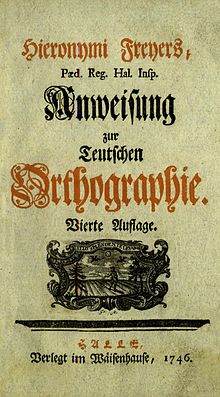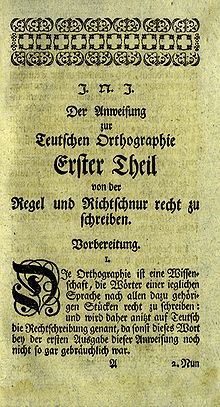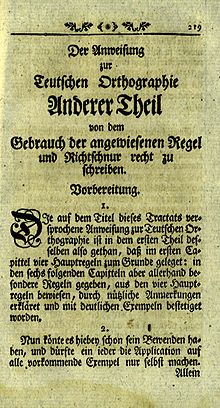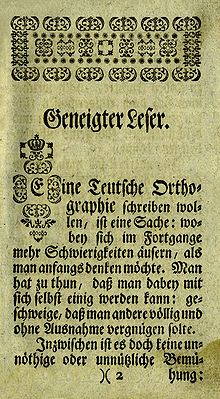Instructions for German orthography
Instructions for Teutschen Orthographie is a textbook by Hieronymus Freyer from the year 1722, with which he standardized the teaching of the Francke Institutes .
history
From 1705 Hieronymus Freyer was inspector of the Pedagogium Regium of the Francke Institutes in Halle. In addition to his work as a teacher and inspector, he wrote programs for the exams and larger educational works every six months . One of the best-known works is his instruction on Teutsche Orthographie , which appeared in four editions from 1722 to 1746. In 1982, a total of 57 copies of all editions were recorded in Germany and abroad.
Table of contents of the 4th edition from 1746
- Brief content of the whole book. The first part deals with the rule and rule of writing correctly.
- The I Capittel of Pronuntiation or Pronunciation.
- The II Capittel Of the letters.
- The III chapter of the syllables.
- The IV Capittel Of Whole Words.
- Das V Capittel From the construction.
- The VI Capittel Of The Distinguishing Signs.
- The VII Chapter of the Abbreviations.
- The other part of writing correctly on the use of the rule and guideline given.
- The Chapter I Of the writing of certain words which are written in one way, also have a sound, but are of different meanings.
- Chapter II of the writing of certain words which are written in different ways and have different meanings: but still have one sound.
- Chapter III On the writing of certain words, which are written in different ways, also have different meanings: but have almost the same sound.
- Chapter IV On the writing of certain words, which, in addition to pronuntiation, can also be seen in particular on derivation.
- The V Chapter On the writing of certain words, which, in addition to pronouncing, can also be seen in particular on the analogy.
- Chapter VI On the writing of certain words, which, in addition to pronouncing, can also be seen in particular on the vsum .
- Chapter VII On the writing of certain words taken from other languages.
content
The work has two parts and begins with a foreword: Inclined reader. Wanting to write a German orthography is one thing: in the process, more difficulties arise than you might think at first. One has to do that one can thereby come to an agreement with oneself: let alone that one should amuse others completely and without exception.
According to today's standards, the first part is an orthographic textbook and the second part an orthographic dictionary .
In the first part, Freyer formulates four main rules of writing: observance of pronunciation, descent, analogy and writing usage. It shows in which cases one or the other rule takes precedence over the first main rule. Then he explains the alphabet, vowels and consonants, the construction of syllables and hyphenation. The following are rules for special words: words with the same sound and different meanings (homophones) , words with different sounds and the same meaning ( synonyms) and foreign words. In the chapter Von der Construction grammatical rules are included: declination , conjugation , congruence , rectification and parenthesis . The first part concludes with three rules about abbreviations.
The second part is to be seen as a dictionary in alphabetical order, but broken down according to aspects from the first part. The first and second chapter collects homophones with the same and different spelling, the third almost identical- sounding words, the fourth words written according to the derivative, the fifth words in analogous spelling, the sixth words in which every rule is based on the use of writing and the seventh the foreign words.
The book has an appendix with an alphabetical index of the most common irregular verbs and three registers on the most noble things, on the incorrect words and constructions, and the correct words and constructions .
effect
The instruction on German orthography occupies an important position in the history of orthography. Hieronymus Freyer recorded the use of writing, systematized it and expressed it in rules. The established system is still valid today.
literature
- Eva-Maria Heinle: Hieronymus Freyer's instruction on German orthography. Carl Winter Universitätsverlag, Heidelberg 1982. Dissertation University of Augsburg 1982, ISBN 3-533-03228-0 paperback, ISBN 3-533-03229-9 linen.
- Petra Ewald (Ed.): Hieronymus Freyer. Instructions for German orthography. Hall 1722. Reprint: Olms, Hildesheim 1999, ISBN 3-487-10879-8 .
- Peter von Polenz : German language history. Volume II. Walter de Gruyter, Berlin 1994, ISBN 3-110-13436-5 .
- Friedrich August Eckstein: Freyer, Hieronymus . In: Allgemeine Deutsche Biographie (ADB). Volume 7, Duncker & Humblot, Leipzig 1877, pp. 367-369.
Individual evidence
- ^ Peter von Polenz: German language history. Page 156
- ^ Eva-Maria Heinle: Hieronymus Freyer's instruction on Teutsche Orthographie. Heidelberg 1982, page 319





